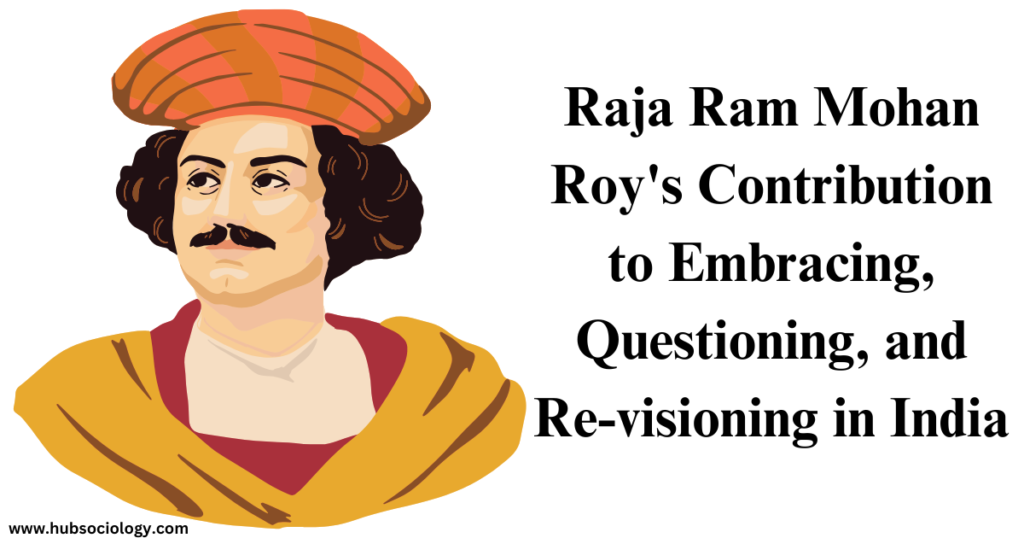Raja Ram Mohan Roy, often hailed as the “Father of the Indian Renaissance,” was a visionary social reformer, thinker, and intellectual who played a pivotal role in shaping modern India. His contributions to Indian society were not limited to religious or political reforms but extended to the broader sociological transformation of a nation grappling with colonial domination, rigid traditions, and social inequalities. Roy’s work can be understood through the lens of three key sociological processes: embracing modernity, questioning entrenched norms, and re-visioning Indian society. His efforts laid the foundation for a more inclusive, rational, and progressive India.

Embracing Modernity: Bridging Tradition and Progress
Raja Ram Mohan Roy’s life and work were marked by a profound engagement with modernity. Born in 1772 in Bengal, Roy grew up in a society deeply rooted in traditional Hindu practices, yet he was exposed to diverse cultural and intellectual influences. His education in Persian, Arabic, Sanskrit, and later English allowed him to access a wide range of philosophical and religious texts, from the Vedas and Upanishads to the works of European Enlightenment thinkers.
Roy’s embrace of modernity was not a wholesale rejection of Indian traditions but an attempt to synthesize the best of both worlds. He recognized the value of scientific rationalism, individual rights, and democratic ideals emerging from the West, while also appreciating the spiritual and philosophical depth of Indian thought. This synthesis is evident in his founding of the Brahmo Samaj in 1828, a socio-religious movement that sought to reform Hinduism by discarding superstitions and rituals while emphasizing monotheism, reason, and social justice.
From a sociological perspective, Roy’s embrace of modernity was a response to the changing dynamics of colonial India. The British colonial administration introduced new systems of education, governance, and economy, which created both opportunities and challenges for Indian society. Roy understood that for India to progress, it needed to engage with these modern ideas and institutions. He advocated for English education, believing that it would equip Indians with the tools to participate in the modern world and challenge colonial domination.
Roy’s efforts to modernize Indian society were not without resistance. Orthodox sections of society viewed his ideas as a threat to traditional authority and cultural identity. However, Roy’s approach was not one of blind imitation but of critical engagement. He sought to adapt modernity to the Indian context, ensuring that progress did not come at the cost of cultural erasure.
Questioning Entrenched Norms: Challenging Social Injustices
One of Raja Ram Mohan Roy’s most significant contributions was his relentless questioning of entrenched social norms and practices. He was a vocal critic of the caste system, gender inequality, and religious orthodoxy, which he saw as impediments to social progress and human dignity. His critique was rooted in a deep sense of justice and a commitment to universal human values.
Roy’s campaign against sati, the practice of widow immolation, is perhaps his most well-known reform effort. Sati was a deeply entrenched tradition in certain Hindu communities, justified by religious texts and social customs. Roy challenged this practice on both moral and rational grounds. He argued that sati was not sanctioned by the Vedas and that it perpetuated the subjugation of women. His efforts, along with those of other reformers, eventually led to the abolition of sati by the British government in 1829.
From a sociological perspective, Roy’s critique of sati was part of a broader challenge to patriarchal structures in Indian society. He advocated for women’s education and property rights, recognizing that gender equality was essential for social progress. His work laid the groundwork for later feminist movements in India.
Roy also questioned the rigidities of the caste system, which he saw as a source of social division and inequality. While he did not call for the complete abolition of caste, he sought to mitigate its oppressive aspects by promoting social harmony and equal opportunities for all. His emphasis on individual dignity and meritocracy was a radical departure from the hierarchical norms of his time.
In addition to caste and gender, Roy challenged religious orthodoxy and superstition. He criticized the dominance of priests and the proliferation of rituals that he believed had no basis in reason or scripture. His efforts to reform Hinduism were aimed at making it more inclusive, rational, and relevant to contemporary life. This questioning of religious authority was a significant step toward the democratization of Indian society.
Re-visioning Indian Society: A Blueprint for the Future
Raja Ram Mohan Roy’s contributions went beyond critique and reform; he also offered a vision for a new India. His re-visioning of Indian society was based on the principles of rationality, equality, and humanism. He envisioned a society where individuals were free to think critically, where social hierarchies were dismantled, and where progress was guided by reason and justice.
Roy’s vision was deeply influenced by his engagement with Enlightenment thought. He admired the ideals of liberty, equality, and fraternity and sought to apply them to the Indian context. However, his vision was not a mere imitation of Western models but a unique synthesis of Indian and Western ideas. He believed that India could draw on its rich cultural heritage while embracing the best of modernity.
One of the key aspects of Roy’s re-visioning was his emphasis on education. He believed that education was the key to social transformation and individual empowerment. He advocated for a modern, secular education system that would equip Indians with the knowledge and skills needed to navigate the challenges of the modern world. His efforts led to the establishment of institutions like the Hindu College in Calcutta, which became a center of intellectual and cultural activity.

Roy’s vision also included a commitment to social justice and human rights. He was a staunch advocate for freedom of expression, religious tolerance, and the rule of law. His work laid the foundation for the development of a civil society in India, where individuals could participate in public life and hold those in power accountable.
From a sociological perspective, Roy’s re-visioning of Indian society was a response to the dual challenges of colonialism and tradition. He recognized that India needed to break free from the shackles of both external domination and internal oppression. His vision was one of self-reliance, where Indians would take charge of their own destiny and build a society based on justice and equality.
Legacy and Relevance Today
Raja Ram Mohan Roy’s contributions to embracing, questioning, and re-visioning Indian society remain profoundly relevant today. His emphasis on rationality, social justice, and human dignity continues to inspire movements for reform and progress. In a world grappling with issues of inequality, intolerance, and cultural conflict, Roy’s vision offers a roadmap for building a more inclusive and equitable society.
Roy’s legacy is particularly significant in the context of contemporary debates about tradition and modernity. His ability to critically engage with both Indian and Western ideas provides a model for navigating the complexities of a globalized world. His commitment to education and social reform reminds us of the importance of investing in human capital and empowering marginalized communities.
In conclusion, Raja Ram Mohan Roy’s contributions to Indian society were transformative and far-reaching. Through his embrace of modernity, his questioning of entrenched norms, and his re-visioning of Indian society, he laid the foundation for a more progressive and inclusive India. His work serves as a testament to the power of ideas and the enduring relevance of social reform in shaping the destiny of nations. As we continue to grapple with the challenges of our time, Roy’s legacy offers both inspiration and guidance for building a better future.

Topic Related Questions
5-Mark Questions (Short Answer)
- Who was Raja Ram Mohan Roy, and why is he called the “Father of the Indian Renaissance”?
- What was Raja Ram Mohan Roy’s role in the abolition of sati?
- Explain Raja Ram Mohan Roy’s views on women’s education and rights.
- How did Raja Ram Mohan Roy contribute to the modernization of Indian society?
- What were the main objectives of the Brahmo Samaj founded by Raja Ram Mohan Roy?
- How did Raja Ram Mohan Roy challenge religious orthodoxy in India?
- Discuss Raja Ram Mohan Roy’s efforts to promote English education in India.
- What was Raja Ram Mohan Roy’s stance on the caste system?
- How did Raja Ram Mohan Roy bridge Indian traditions and Western modernity?
- What role did Raja Ram Mohan Roy play in the socio-religious reform movements of the 19th century?
10-Mark Questions (Detailed Answer)
- Discuss Raja Ram Mohan Roy’s contributions to the emancipation of women in 19th-century India.
- Analyze Raja Ram Mohan Roy’s role in questioning and reforming Hindu religious practices.
- How did Raja Ram Mohan Roy’s ideas on education contribute to the modernization of Indian society?
- Examine Raja Ram Mohan Roy’s efforts to promote rationalism and scientific thinking in India.
- Discuss the significance of the Brahmo Samaj in the context of India’s social and religious reform movements.
- How did Raja Ram Mohan Roy’s critique of the caste system contribute to social equality in India?
- Evaluate Raja Ram Mohan Roy’s role as a bridge between Indian traditions and Western Enlightenment ideas.
- What were the key challenges faced by Raja Ram Mohan Roy in his efforts to reform Indian society?
- Discuss Raja Ram Mohan Roy’s vision for a modern and progressive India.
- How did Raja Ram Mohan Roy’s work lay the foundation for later social reform movements in India?
15-Mark Questions (Essay-Type Answer)
- Critically analyze Raja Ram Mohan Roy’s contributions to embracing modernity, questioning traditions, and re-visioning Indian society.
- Discuss Raja Ram Mohan Roy’s role in the socio-religious reform movements of 19th-century India. How did his ideas influence the Indian Renaissance?
- Examine Raja Ram Mohan Roy’s efforts to challenge social injustices such as sati, caste discrimination, and gender inequality.
- How did Raja Ram Mohan Roy’s synthesis of Indian traditions and Western modernity contribute to the shaping of modern India?
- Evaluate Raja Ram Mohan Roy’s legacy in the context of contemporary debates on tradition, modernity, and social reform in India.
- Discuss the impact of Raja Ram Mohan Roy’s reforms on the empowerment of women and marginalized communities in India.
- Analyze the role of Raja Ram Mohan Roy in promoting rationalism, secularism, and humanism in Indian society.
- How did Raja Ram Mohan Roy’s vision for education and social reform contribute to the emergence of a modern Indian identity?
- Critically examine Raja Ram Mohan Roy’s contributions to the abolition of sati and its significance in the context of women’s rights in India.
- Discuss Raja Ram Mohan Roy’s role as a social reformer and his impact on the Indian Renaissance. How relevant are his ideas in today’s society?
